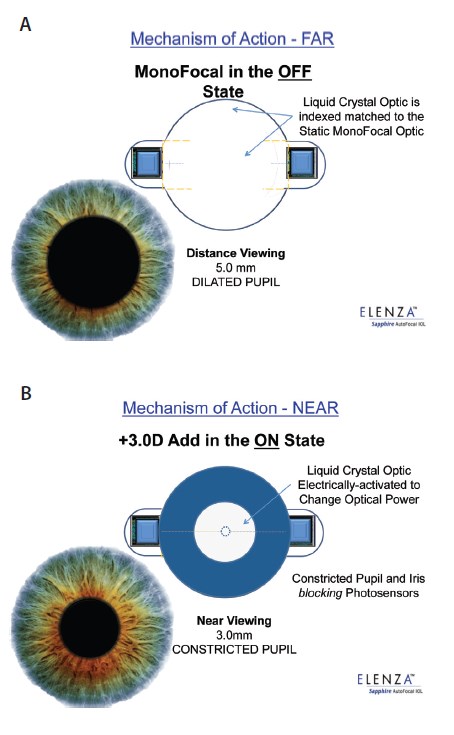I have seen the future of presbyopic surgery, and, in my estimation, it is the Sapphire AutoFocal IOL (Elenza; Figure 1). For years, refractive cataract surgeons have been waiting for a true accommodating IOL to replace multifocal IOLs in the management of presbyopia during cataract surgery. Unfortunately, the overwhelming problem with the current generation of accommodating IOLs is that their functioning requires the movement of the capsular bag or of the lens within the capsular bag, both of which depend upon the intraocular muscles. In many patients, the capsular bag contracts and hardens with age and, thus, becomes less pliable and less prone to movement. Elenza has sought to address these obstacles with the Sapphire AutoFocal IOL.

Figure 1. The Sapphire IOL has an aspheric central optic and an electroactive liquid crystal section.
HOW DOES IT WORK?
With the Sapphire, visual accommodation can occur without movement of the lens implant. Rather, accommodation occurs via activation of an electroactive liquid crystal optic encapsulated within an aspheric monofocal IOL. The lens contains a photovoltaic cell with photosensors that monitor the patient's pupillary dynamics associated with accommodation. The lens contains onboard processors that recognize the pupil's size in relation to illumination, enabling patient-specific programming so that the lens can provide accommodation based on the patient's individual and specific pupillary movements.
The solid-state, rechargeable power cell activates a liquid crystal optic that changes between distance and near upon physiologic triggers during near vision, and encapsulated microcoils enable two-way communication and induction recharging of the power cells.
Sizing and centration are crucial with mechanical accommodating IOLs, but not with the Sapphire. The IOL does not have to capture energy from the patient's aging eye, and hardening of the capsular bag does not affect it.
AT A GLANCE
• With the Sapphire AutoFocal IOL, accommodation
occurs via activation of an electroactive liquid crystal
optic encapsulated within an aspheric monofocal IOL.
•
If the electronics fail for any reason, the lens defaults to
a monofocal IOL.
IS IT SAFE AND RELIABLE?
Safety. The Sapphire's power cells, electronics, and liquid crystal components are hermetically sealed in a glass wafer encapsulated in an acrylic IOL. If the electronics fail for any reason, the lens defaults to a monofocal IOL.
Reliability. A physiologic trigger activates the lens. Patients have a universal response to near vision; when their eyes converge during accommodation, the pupil contracts. Constant illumination and constriction of the pupils are pathognomonic signs of accommodation that trigger the Sapphire to provide 3.00 D of functional near vision add. The pupillary dynamics behind the selection of this amount are based on a 300-patient study of pupillary dynamics.1 The algorithm's validation was based on 100 pseudophakic patients and 50 pre- and postcataract surgery patients who underwent eight experiments performed under various lighting levels. The algorithm was further validated by the study of an additional 100 patients masked to the algorithm. The major findings of this research are outlined in the accompanying graphic, Research Findings.

OTHER FEATURE OF THE LENS
The dynamic optic can be activated automatically based on pupillary response to an accommodative stimulus. The system also has a manual override, with a specific blink response that can initiate accommodation and an emergency switch to turn off the accommodation.
When the patient is seeing at distance, liquid crystals in the lens are used as binary dynamic modulators of traction. In the off state, they provide distance vision. In the on state, the liquid crystals are converted to a near 3.00 D add with the transmission of greater than 90% of light and an efficiency greater than 95%, according to laboratory testing (Figure 2).
To me, one of the most interesting aspects of this lens is that it will require recharging. The process can be performed over distances of as great as 20 cm with a sleep mask, pillow, or contour neck pillow.

Figure 2. Mechanism of action of the Sapphire IOL: For distance vision (A), the lens works as a monofocal IOL; for near (B), the liquid crystals are converted to a near 3.00 D add.
CONCLUSION
Having worked with the manufacturer and having seen the technology, I am certain that, given the proper amount of time and further development, this technology will be a major step forward in the treatment of presbyopia with lens-based surgery. Elenza is currently working on securing additional funding.
1. Donnenfeld E, Zikos G, Robilotto R, Gupta A, Morris M. The effect of cataract surgery on the pupil light response. Poster presented at: the XXXI Congress of the ESCRS; October 5-9, 2013; Amsterdam, Netherlands.
Eric D. Donnenfeld, MD
- Professor of Ophthalmology, New York University
- Trustee of Dartmouth Medical School, Hanover, New
Hampshire
- ericdonnenfeld@gmail.com
- Financial disclosure: Consultant, Medical Monitor (Elenza)
